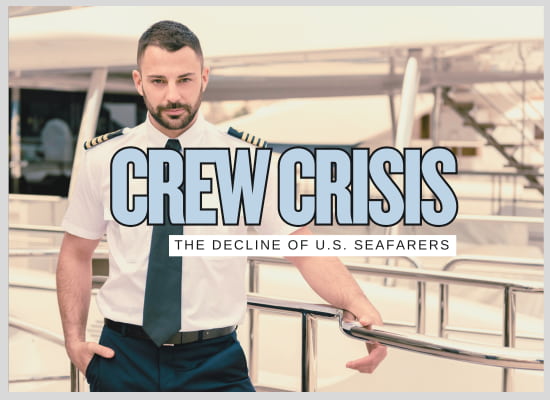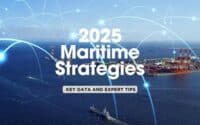10 Reasons America Doesn’t Have Enough Mariners in 2025

The United States is racing to expand its maritime power — but there's one massive problem: not enough people to run the ships. You could, of course, argue that controversial trade policies and shifting global alliances play a role in the current challenges — and you'd be right. But this report focuses on something more fundamental: the crew. The men and women needed to operate, maintain, and sail the vessels that power America's commercial and strategic interests are in short supply — and getting harder to replace.
In 2025, the U.S. finds itself in a full-blown mariner shortage, threatening everything from military sealift capacity to commercial fleet growth. While ships wait at anchor and new vessels hit the orderbooks, qualified mariners are retiring faster than they’re being replaced. But why is this happening — and what can be done?
Here are 10 eye-opening reasons behind the mariner shortfall that’s quietly reshaping America’s maritime future.

We welcome your feedback, suggestions, corrections, and ideas for enhancements. Please click here to get in touch.
The U.S. merchant fleet is staffed by a generation of mariners nearing retirement age, and new recruits aren’t arriving fast enough to fill their shoes. With fewer young people entering the industry and many seasoned professionals stepping away, the pipeline is shrinking at both ends. It’s not just a workforce issue — it’s a looming crisis for fleet capacity and national readiness.
📉 The Problem:- Roughly 20–25% of active U.S. mariners are approaching retirement within the next 5 years.
- There’s a steep drop-off in newly licensed officers, leaving mid-level and senior roles unfilled.
- Loss of experience impacts everything from vessel safety to training and mentoring of cadets.
- Reduces available crewing for both commercial and sealift missions.
- Increases pressure on younger mariners to move up before they’re fully seasoned.
- Forces vessel operators to scramble for staffing on short notice — often at a premium.
- Succession planning and mentorship programs from within the industry.
- Targeted outreach to youth and veterans to build a more robust talent pipeline.
- Modern incentives (retention bonuses, lifestyle flexibility) to keep older mariners longer.
Despite offering high-paying, global, and technically advanced career paths, maritime professions remain largely invisible to most American students and job seekers. Unlike aviation, engineering, or healthcare, maritime careers rarely appear in career fairs, school programs, or mainstream media. This lack of visibility is quietly starving the industry of new talent.
📉 The Problem:- Few young Americans can describe what a merchant mariner does — let alone how to become one.
- STEM-focused students are more likely to be recruited into tech or aerospace than maritime fields.
- Even coastal communities often lack maritime career promotion in their public schools.
- Maritime academies struggle to fill rosters or draw diverse applicants.
- Fewer young professionals are available to replace retiring senior mariners.
- The image of seafaring as an outdated or “invisible” job deters ambitious talent.
- National-level awareness campaigns to rebrand maritime careers for the next generation.
- Inclusion of maritime career tracks in school STEM programs and technical colleges.
- Stronger outreach partnerships between shipping companies, unions, and education systems.
Life at sea isn’t for everyone — and today’s younger workforce is far less willing to endure the physical strain, isolation, and long deployments that come with maritime work. Compared to shore-based jobs offering flexibility and remote options, a career at sea can seem tough, outdated, or even undesirable.
📉 The Problem:- Standard contracts can keep mariners away from home for weeks or months at a time.
- Living conditions on some vessels remain basic or cramped, especially on older tonnage.
- Long hours, heavy labor, and mental fatigue are common — with limited support.
- High turnover among younger mariners who leave the industry early.
- Difficulty attracting new recruits, especially when competing with more flexible industries.
- Increased demand for mental health support and crew welfare programs.
- Modernized vessel conditions — better Wi-Fi, privacy, recreation, and nutrition.
- More flexible rotations and rest schedules to reduce burnout.
- Proactive investment in crew welfare, training, and mental health resources.
The maritime skillset is valuable — but that’s part of the problem. Today’s mariners are being pulled into other sectors like logistics, offshore energy, and tech-driven industries that offer higher pay, better benefits, and the ability to stay closer to home. With so many competitive alternatives, seafaring careers are losing talent before it even steps aboard.
📉 The Problem:- Marine engineers and navigators are being recruited into shoreside operations, supply chain management, and energy roles.
- Higher salaries, remote work options, and career growth paths lure potential mariners to land-based careers.
- Veterans and mid-career professionals are pivoting away from long-term sea service.
- Fewer qualified mariners are available for specialized vessel operations or senior roles.
- Shipping companies are forced to raise pay or outsource crewing internationally.
- The talent pool for U.S.-flag vessels becomes increasingly shallow and unstable.
- Competitive compensation packages that rival onshore industries.
- Clearer career ladders and long-term incentives for staying in the maritime workforce.
- Efforts to reframe seafaring as a high-tech, globally relevant profession — not just a job.
While the U.S. has several respected maritime academies, they can only graduate so many cadets each year — and that number isn’t enough to keep up with the industry’s needs. Add in the high cost of education, limited sea time availability, and complicated licensing processes, and many would-be mariners never make it to sea.
📉 The Problem:- U.S. maritime academies are producing fewer licensed officers than industry demand requires.
- High tuition costs and living expenses deter students without financial backing or sponsorships.
- Cadets struggle to secure required sea time slots due to vessel availability constraints.
- Slow onboarding of entry-level talent across both commercial and government fleets.
- Vessel operators face longer hiring lead times and recruitment gaps.
- Younger mariners may be less prepared due to limited hands-on experience at sea.
- Expanded training berths and funding for U.S. cadets across both public and private academies.
- Increased government investment in maritime education incentives and scholarships.
- Streamlined pathways to sea time and licensing, especially for community college and veteran programs.
With fewer U.S.-flagged commercial vessels in operation, there are simply fewer jobs available for American mariners. Decades of globalization, foreign-flag competition, and limited fleet renewal have led to a gradual erosion of the U.S. merchant fleet — and with it, the opportunities to sail under the Stars and Stripes.
📉 The Problem:- The number of active U.S.-flagged vessels has steadily declined, reducing domestic job availability for licensed mariners.
- More maritime work is being outsourced to international fleets with lower labor costs.
- Without ships to sail on, even qualified mariners are pushed out of the industry.
- Limited sea-time and career progression options for cadets and junior officers.
- Increased difficulty maintaining sealift readiness and Jones Act coverage.
- Growing reliance on foreign crews and foreign-flag operators in U.S. ports.
- Incentives for operators to maintain or expand U.S.-flagged fleets.
- Modernization support for aging vessels and tonnage renewal programs.
- Government policies that balance global competitiveness with U.S. maritime sovereignty.
Becoming a professional mariner in the U.S. involves navigating a maze of certifications, medical clearances, background checks, and ongoing training. While safety is critical, the complexity and cost of compliance often discourage otherwise capable individuals from joining — or staying in — the industry.
📉 The Problem:- Entry into the profession requires multiple credentials: MMC, TWIC, STCW, medical exams, and more — each with their own fees and paperwork.
- Many mariners struggle with keeping certifications current, especially between contracts.
- The approval and renewal process can be slow, confusing, and inconsistent across agencies.
- Creates barriers to entry for young, low-income, or career-switching individuals.
- Forces some experienced mariners to leave the industry when credentials lapse.
- Delays in processing can leave ships short-staffed or crew changes disrupted.
- Simplified credentialing paths with clearer guidance for first-time mariners.
- Subsidies or grants to offset the high upfront cost of compliance.
- Improved digital systems and faster processing timelines for renewals and endorsements.
The COVID-19 pandemic intensified the strain on the maritime workforce. With travel restrictions, extended contracts, and delayed crew changes, many mariners faced harsh conditions — and some never returned to sea. The ripple effects are still felt across the industry, especially in recruiting and retention.
📉 The Problem:- Thousands of mariners were stuck at sea beyond contract terms with limited shore access.
- Global crew change disruptions made it harder to rotate fresh personnel.
- Health concerns and mental exhaustion caused many to exit the profession early.
- Accelerated attrition among mid-career mariners and early retirements.
- Fewer applicants entering maritime academies or training pipelines.
- Lingering mental health challenges and skepticism about long-term sea life.
- Ongoing support for crew wellness, including mental health resources.
- Emergency protocols to prevent repeat scenarios in future global crises.
- Rebuilding trust in maritime careers with improved working conditions post-pandemic.
Despite growing concerns from industry leaders, government support for rebuilding the American mariner workforce has been slow and inconsistent. While programs exist, they often lack the funding, visibility, or coordination needed to make a real impact — leaving fleet operators and academies to fill the gaps on their own.
📉 The Problem:- Few large-scale federal programs directly address recruitment or retention of U.S. mariners.
- Policy discussions often focus on fleet size, not the people needed to crew it.
- Long delays in implementing workforce initiatives, even after public calls for action.
- Ship operators lack financial incentives to hire and train American crews.
- Maritime academies struggle without sustained public investment or grants.
- Loss of global competitiveness due to weak crewing pipelines and flag-state support.
- Targeted federal funding for mariner scholarships, credentialing, and job placement.
- Public-private partnerships to support training, apprenticeships, and outreach.
- Legislation that treats U.S. mariner workforce development as a strategic priority.
Mariners are essential to global trade, disaster response, and national security — yet their work often goes unnoticed. Unlike other service professions, merchant mariners rarely receive the recognition they deserve, which can lead to low morale, limited advocacy, and difficulty inspiring the next generation to step aboard.
📉 The Problem:- Most Americans are unaware of the role mariners play in supplying everyday goods.
- Merchant shipping is absent from mainstream education, media, and career discussions.
- Lack of recognition leads to fewer role models and minimal public support for maritime issues.
- Harder to build long-term career appeal, especially for young recruits.
- Less political momentum to address crewing shortages or invest in maritime education.
- Disconnect between public perception and the real strategic value of the merchant fleet.
- Public awareness campaigns that highlight the lives and contributions of U.S. mariners.
- Integration of maritime topics into schools, career fairs, and STEM programs.
- Celebration of mariner achievements during national holidays and industry events.
📝 Table Summary

Do you have a Maritime Product or Service that may be of interest to Shipowners? Tell us about it here!
Do you have feedback or insights? Please reach out to editor @ shipuniverse.com



